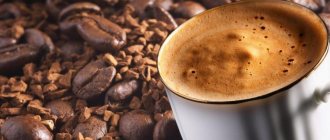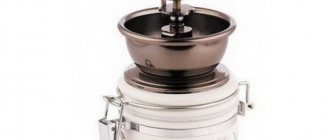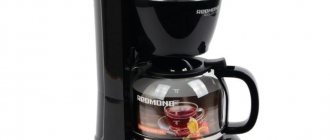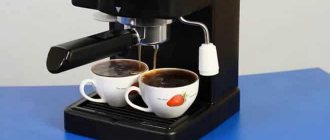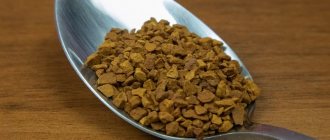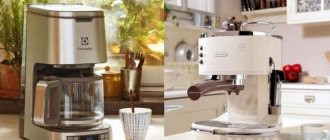Why roast beans at home?
Coffee that has been roasted in advance can be delicious. However, even the best coffee beans begin to lose their rich taste and aroma a short time after roasting. If you want to make real coffee at home, it's time to get your own roaster. Then you can enjoy fresher and tastier coffee.
Don't want to read? You can't go wrong with a Nesco roaster. It is easy to use and can roast large quantities of beans.
Electric roasters
The operation of electrical devices is based on heating the heating element. The total period of work is up to 6 years. The beans in the devices are fried as evenly as possible - it is possible to lower and increase the temperature. The main problem: it is difficult to achieve a sharp increase in temperature.
Be sure to read: Which professional carob coffee machines can be used at home
Modern models are equipped with manual or semi-automatic control. Available profiles:
- French press;
- filter coffee maker;
- other roasting methods.
Home appliances are installed near the hood.
Daniil Lobadin
Co-founder and head of the family manufactory Lobadin Coffee Roasters
Yes, yes and yes: A GOOD oven for roasting grains is a must-have, without which you cannot get a multifaceted drink, rich in flavor and aromatic nuances. Our Lobadin Coffee Roasters manufactory uses an American Loring convection roaster. The pleasure is not cheap, there are fewer such cars in Russia than there are fingers on our hands, but what potential the car has, oh, just ecstasy! The beans in this roaster are fried with hot air, and not burned, as is usually the case in cast iron ovens (and we know that the “distance” from French roasting to over-roasted beans is very small :)) And thanks to this, we can endlessly experiment with specialties , “pulling” ever new combinations of tastes and aromas from the grain) As for the home roaster... Well, they gave people a task! In our opinion, this matter is better left to the pros - no offense, but listen... We don’t try to milk a cow ourselves to get milk - we leave the work to those who know how to do it, and then add the resulting milk to our coffee. True, without experience, without excellent equipment, it is very, very easy to spoil the grains! The taste of coffee is affected by every second, every change in temperature, and almost every movement of the roaster!
— Daniil Lobadin Co-founder and head of the family manufactory Lobadin Coffee Roasters
The best coffee roasters
Thanks to us, you won't have to do fortune-telling using coffee grounds. We have selected several coffee roasters that have all the necessary functions. My pleasure.
Roaster for coffee beans Nesco CR-10-10-PR
If you have a lot of coffee lovers in your house who are eager to get their morning cuppa, then you're probably already into roasting yourself.
You can simplify things if you use this roaster. It can roast up to 142 g of coffee beans at a time. This will make enough for 36 cups of coffee - although this depends on how many beans you use for your coffee. After all, it could be one very large mug consumed before an office meeting on Monday at 8am. Nesco CR-10-10-PR has advanced odor and smoke elimination features, so you won't feel like you're in Firestorm while roasting. It is easy to load beans into the roasting chamber, and the menu controls are simple and intuitive. This machine is a great choice for those just getting into roasting or those taking it to the next level after previously popping beans in a popcorn maker or manual model.
Approximate cost: $137.00
Drum roaster Behmor Plus Customizable
You may have been at your local coffee shop and marveled at the drum roasters and the wonderful smell that came from the machines.
Of course, you can build such a machine yourself, and you can also bring home this neat and relatively small roaster from Behmor. This machine is the size of a small microwave. It is slightly larger than other, cheaper coffee roasters.
But you can roast up to 454 g of coffee beans at a time. If you make and drink many servings of coffee per week, then this model will save you time and effort. The device contains a smoke elimination system and also has five different roasting cycles. The roasting chamber is illuminated so you can observe the coffee beans.
Approximate cost: $399.00
Automatic roaster for coffee beans FreshRoast SR500
Are you short on kitchen space but still want to roast beans at home?
Set aside some space in your kitchen for the FreshRoast SR500. Despite its modest size, the device has many functions. For example, it has a fan whose speed can be adjusted, as well as three temperature settings.
This model allows you to roast 90 g of coffee at a time. That's 21 cups of coffee, so you can invite friends over without worrying about roasting extra coffee. Combined with uncomplicated operation and easy cleaning, you get a roaster that is ideal for small coffee brewing spaces.
Approximate cost: $189.00
Manual ceramic roaster for coffee beans Nuvo Eco
After a good coffee, just like after exercise, you feel energized.
Why not combine roasting coffee with a moderate-intensity workout? To make delicious roasted beans in the Nuvo Eco Ceramic Manual Roaster, you only need two things: fire and the desire to move around while roasting. Up to 70 g of beans are placed in this manual roaster at a time, and they are roasted over an open fire. Of course, such volumes will not be enough for a crowd, but you will have fun in the morning thanks to the movement and the unique appearance of the roster. If you like arts and crafts and make coffee for 1-2 people every day, then this model is for you.
Approximate cost: $30.00
Popcorn maker Presto PopLite
We know what you're thinking: "Do you want me to roast my coffee in this?"
Be strong. Although these devices are designed to make popcorn crisp, Presto PopLite popcorn makers will roast coffee beans just as well. In fact, popcorn makers have their fans, because you can make both popcorn and coffee in them. This method of roasting coffee beans requires more attention to detail and more care than with other machines. You will have to roast coffee outside the home, and the device will only fit no more than 90 g of beans at a time. However, this model has built-in ventilation and an automatic husk removal system. All this, as well as its relative affordability compared to professional roasters, make this model a good option for those who are on a budget or just getting started with coffee roasting.
Approximate cost: $18.23
Retro coffee roaster Hario
Good coffee is a kind of art.
If you want to feel like a master of your craft, you'll love carefully twisting this retro-style glass roaster while holding it over the fire of a spirit lamp and watching the beans roast. You can quietly hum Mumford & Sons songs while you do this - this is optional, but recommended. Only 50 g of beans will fit into this machine at a time. This Japanese coffee roaster emphasizes patience, artistry, and craftsmanship. With its unique design, this model can become the talk of the town. If you want every cup of coffee you make to be not just a drink, but an entire experience, then this model is for you.
Approximate cost: $239.46
Stainless steel Nesco 481825PR coffee roasting oven
With this device from Nesco, you can learn how to use a professional roaster that doesn't come at a professional price.
The power of this model is 1425 Watts and the capacity is 17 liters. She can roast a Thanksgiving turkey just as easily as she can roast coffee beans. The device can withstand high temperatures – up to 232°C. You can tinker with different roasting recipes as you please, trying to create the perfect cup of coffee. This machine is quite large and will take up a lot of space in the kitchen. With a mid-range price and powerful roasting settings, this model is a good choice if you frequently roast coffee in large batches and want quality to match quantity.
Approximate cost: $90.08
Great Northern Popcorn Stainless Steel Stovetop Popcorn Maker
Roast coffee like cowboys.
Well, or at least like your grandparents in the 50s. If you prefer to be hands-on in the process and want a feature-rich, high-capacity device, then you'll love roasting coffee beans in the stainless steel popcorn maker from Great Northern Popcorn. Thanks to the built-in stirring system, your beans will roast evenly. This small device is easy to clean and store, so you don't have to waste valuable kitchen space when it's not in use.
Approximate cost: $90.08
How to choose the best green grain processing equipment?
It is unlikely that you will be able to buy roasters for roasting coffee in electronics or kitchenware stores in Moscow. This technique is considered professional, so this can be done in specialized online stores. Most models allow you to visually control the grain roasting process due to a transparent drum, which makes mastering the features much faster and better.
The price of the equipment is quite high, so you need to carefully approach the purchase. You can order online on our website or by phone by calling our managers at number 8. If you have any questions or need help in choosing a model, we will always be happy to help and recommend the best for you.
Benefits of home coffee roasting
All coffee lovers prefer to control the process of preparing their favorite drink in everything. We always need to achieve a high level of skill in this - and for this we can buy a semi-automatic espresso machine or meticulously improve in the pour-over method. But is it worth it to spare your time and effort and start roasting coffee beans yourself?
One of the benefits of roasting your own beans is that you can create your own coffee blends. This means that you can adjust the degree of roasting, select the country of origin of the beans, etc. You will be able to control everything, except, perhaps, the weather conditions in which the coffee was grown, and that’s cool.
You will also be able to control the degree of roasting. As you'll learn from this roast level guide, there are no exact standards in this area. If you roast your own coffee, you'll know exactly what you're getting. This is why you can achieve the perfect roast (with some practice).
Finally, it's just fun! We all like to have hobbies and take time for ourselves. Roasting coffee allows you to take time out for something you enjoy. It's worth it. (Needless to say, this relieves stress.)
Coffee roast levels
Each roast is a matter of taste. However, when purchasing a roaster, it would be a good idea to ask what degree of roasting it can produce. After all, the growth of the skill in the degree of frying depends on the capabilities of the device. There are several types: weak, medium, strong, high and Italian.
Weak
It is also called Scandinavian. During roasting, which is done at a temperature of 190-200°C, the coffee beans become light brown. The smell is like a bakery - the smell of freshly baked bread. This roast is very good for Arabica varieties. The coffee itself, made from lightly roasted beans, is especially tasty when combined with cream, milk and vanilla sugar. For lovers of stronger coffee, such as espresso, this method will not be to their taste.
Average
In other words, American. Such processing of grains is possible if you do not miss their first crack. The grains burst at a temperature of 210-220°C, when their color already turns brown, but no oils are released on the shell yet. With this processing, a rich aroma is already felt. The coffee tastes like caramel and subtle sourness. And some connoisseurs even recognize a herbal undertone in the flavor palette.
Strong
Otherwise - French or Cuban. The coffee beans turn dark brown and their surface shines - a clear sign of oil release. This degree of roasting can be achieved when the temperature in the roaster reaches 230°C. Coffee made from heavily roasted beans already has a bitter taste. This gives the drink richness and relatively good strength.
Higher
This type of roasting is also called French roasting. The grains are dark brown, their surface is covered with a glossy sheen. It is recommended to fry grains to this degree at a temperature of 240°C, no more. The taste of coffee from such beans is bitter, but some gourmets find this bitterness pleasant.
Coffee made from beans roasted in this way is not for everyone. When trying it for the first time, it is recommended to add a little cream.
A little guide to coffee roast levels
To help you understand what to expect when roasting coffee beans, let’s look at the roast levels.
- Green: the grains will arrive to you in this form. This color will remain for some time at the beginning of the roast.
- Yellow: Green will give way to a more yellow hue. You will be able to notice a herbaceous aroma.
- Steam: Water will begin to evaporate from the beans and you will notice steam. Some roasters have a system that eliminates smoke and steam, but you will still be able to see it.
- First click: Once the steam starts to appear, you will hear clicks. This happens because the grains expand and the sugars go through a process of caramelization. After the first click, the beans will go from New York to Full New York roast. The color of the beans will be medium and the beans themselves should look dry.
- Second Click: You will hear a second, louder click as the beans roast. It serves as a signal that you are moving to darker degrees of roasting. You may notice oily marks on the surface of the beans. We do not recommend waiting long after the second click.
- Burnt beans: If roasting continues after the second click, the smoke will become more acrid and the surface of the beans will become oilier. The sugars will start to burn. If you continue, the roasting temperature may become dangerous and the beans will simply burn and taste unpalatable.
Professional advice
For beginners, we recommend frying until the first click. If you find that you need a darker roast, try to achieve it. If you continue to fry after the second click, you will find yourself in the French frying area. We do not recommend doing this, especially at home.
Even if you like French roast coffee, you should not roast your beans this way due to the high temperatures and large amounts of smoke. Pulling out the beans before the first click is also a bad idea. The Blonde roast isn't that great.
We recommend reaching medium roast levels. You can make the grains a little lighter or darker depending on personal preference. In any case, most people prefer medium roast levels, as this is where the full flavor of the coffee comes out.
Choosing a roaster for your home
Until recently, so-called sample roasters, designed for roasting small quantities of beans, were used mainly in industry. With their help, they determined whether it was worth purchasing a particular batch of coffee. Sample roasters do not require special roasting precision. But these devices are used mainly by professional roasters: sample models are too expensive for home use, and their productivity is excessively high.
The need for mini-devices designed to roast 60–300 g of coffee arose as the popularity of barista championships grew in popularity. Roasters began to be equipped with control panels that allow you to accurately set the temperature and roasting time. Many coffee lovers are still deterred from buying a home mini-roaster by the high price: even the simplest models cost about 300–400 USD.
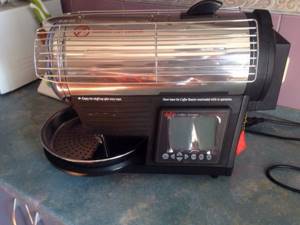
Sample roster (example)
Coffee roasters for home are available in gas and electric. The most common are drum models . The main part of this device is a rotating cylindrical drum. There are blades installed inside it that mix the grains. Coffee is poured into the drum through a loading funnel.
Roasting coffee always produces debris from pieces of husk. To prevent specks from burning, the drum has a forced ventilation system. A stream of hot air created by a gas burner passes through the grains, heats them, picks up light debris and goes into the ventilation pipe (the debris ends up in a special tray). The roaster has a window that allows you to monitor the condition of the beans.
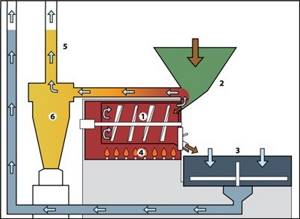
Structure of a drum roaster: 1 – drum with blades inside; 2 – loading funnel; 3 – container for cooling; 4 – burner; 5 – ventilation pipe; 6 – forced ventilation system.
Under normal conditions, the roasting process continues for several minutes after turning off the power source. To prevent this from happening, the roaster has a container for cooling the grains. In it, the coffee is mixed and blown with cold air. Frying lasts 12–20 minutes, cooling – 5 minutes.
Gas roasters
Roasters with an electric motor and a gas burner are more economical than electric ones: gas is cheaper than electricity. It is believed that with careful use the burner will last up to 30 years (however, no one guarantees that the motor will not break during this time). There are models that can run on natural gas, propane or butane.
However, operating a gas roaster requires some experience. The fact is that when coffee is heated, moisture is released, which reduces the temperature of the grain (ROR - Rate Of Rise). A particularly intense release of moisture occurs at the moment of the first crack. Accordingly, the temperature of the grain decreases sharply. In a gas roaster it is difficult to achieve a smooth decrease and the same gradual increase in the temperature of the grains.
When choosing a gas roaster, you should give preference to models with a double drum. In them, the grains are heated more evenly, and the drop and rise in temperature occurs more smoothly than in devices with a single drum.
Types of roasters
Popcorn makers
Obviously, popcorn makers are not technically designed for roasting coffee. However, they are often used for precisely this purpose.
Popcorn makers are not ideal, as the kernels are roasted somewhat unevenly. They are perfect for beginners. With a popcorn maker, you'll be able to figure out if you like toasting beans at all, without wasting too many beans.
If you decide to roast coffee beans at home, we recommend purchasing one of the roasters below to make your life easier.
Air roasters
Air roasters, like popcorn makers, use direct heat or convection. The principle of their operation is that hot air is passed through the frying chamber. As a result, the grains come into direct contact with heat.
Air roasters, like popcorn makers, are usually quite small. They are best suited for those who roast coffee in small batches. If you make coffee for one or want to stock up on beans of different roast levels for the week, then this type of roaster is for you.
Drum roasters
Drum roasters, on the other hand, use conduction, which means indirect contact with heat. Typically, these machines have a rotating roasting chamber. The heat does not contact the grains, but the walls of the chamber. Touching the heated surface, the grains begin to roast.
While air roasters are typically suitable for small portions, drum roasters have a larger capacity. However, we don't recommend roasting more beans than you need for the week. This type of roaster is good for you if your whole family drinks coffee or if you yourself drink several cups of coffee a day.
Types of roasters
There are only 4 main types of roasters. Among them:
- Drums are the most popular type. They allow you to roast grains on an industrial scale. The result is a product that is balanced in taste. Modern models work according to the most balanced formula: conduction and convection are involved. The radiation method is minimized. The roaster has easy maintenance and a long service life. The device rarely needs to replace individual parts.
- Convection . One of the new types is convection. Frying of the product occurs only under the influence of air flow. The main advantage of the device is that the entire process takes minimal time. Main disadvantages: difficult control of individual parts of the process, difficulties in achieving standard roasting.
- Mixed type . Modern devices are often of a mixed type, and they are expensive. According to the principle of operation, these devices resemble drum devices: the drum itself is fixed, and only the blades rotate - this ensures uniform roasting. The burner is located outside the drum. The main emphasis is on convection. The result is a clean, balanced product.
- Sample . One of the smallest devices is a sample. They are suitable for small production: essentially mini. A household roaster, as it is also called, comes in different types of operation: both drum and convection.
Be sure to read: Pros and cons of a pod coffee machine for home
Each device has its own purpose - large production, revealing the taste qualities of the beans, like, for example, a sample device.
Other factors to consider
How long do you fry?
As mentioned earlier, different roasters have different capacities. Before purchasing this device, pay attention to how much coffee you (and other people) consume per week. This time period is ideal as the beans will remain fresh.
Once you know your average coffee consumption, check your roasters' capacities and eliminate models that are too large or small. This will allow you to significantly narrow your search.
Is there a cooling function?
The cooling function is a must if you are serious about roasting coffee. If there is no such mechanism, the beans will continue to roast even after you turn off the heat because the internal temperature of the beans will remain high. This can cause the beans to roast unevenly or burn. This means that popcorn makers should not be used for a long time.
How dark a roast do you want?
When the beans reach a darker roast level, there will be a lot of smoke. Some cars have safety systems that can eliminate this problem, but smoke is virtually unavoidable. Unless the room you're roasting in has very good ventilation, DO NOT go to dark levels.
This could cause the fire safety system to go off and the neighbors to start panicking. In addition, it is simply unsafe to inhale smoke in large quantities. If you still like a dark roast, you should take this into account, buy something that will reduce the amount of smoke to a minimum and improve room ventilation.
The Art of Choice
The first thing a potential buyer and future owner of a unique home appliance for roasting coffee beans needs to know is the performance of the product:
- For personal use, you need to purchase miniature devices with a capacity of up to 300 g. Coffee shop owners will benefit from products that can fry up to 2 kg of green beans in one working cycle.
- Professionals who make money from the art of roasting, fulfilling large orders, prefer universal units with a capacity of at least 2-3 kg.
- If you are planning to open your own business for roasting and subsequent sale of perfectly fried beans to different consistencies, then pay attention to machines with a capacity of 50 kg and above.
- In large factories for processing green beans, units with a capacity of 250 kg per working cycle are installed.
Today we are telling you mainly about home roasters that will allow you to quickly process grains to the desired condition without much effort on the part of the user, you just need to add the beans and set the correct mode.
We remind you once again that such products are not sold in regular household appliance stores; they can only be found in specialized retail outlets that sell coffee and related products. But there will be big markups, and you will find a more reasonable price on Aliexpress, and there is a guarantee that you will not just buy a drum without a heater, but a truly functioning unit.
Numerous manufacturers produce coffee equipment, but sometimes the cost is quite high, so it makes sense to buy used roasters, the cost of which will be half or sometimes three times cheaper.
Remember that after roasting, you need to let the beans brew for at least 12 hours, as experts in these matters say: coffee finally calms down after processing and becomes as tasty as possible within a day. Freshly processed coffee beans begin to lose all their taste after a week of storage, so don’t stock up for future use - the machine is always at hand, and roasting a few grams of coffee is not a problem.


